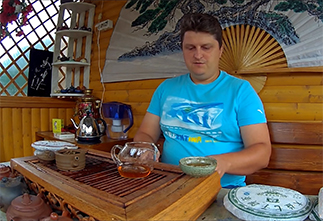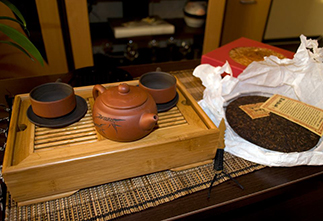Shu Puer 2015 "The Older, the More Fragrant" by Kaishunhao: Treasure of Time
A classic of the genre with deep taste
Shu Puer 2015 "The Older, the More Fragrant" from the famous brand "Kaishunhao" is a true masterpiece of tea art. This tea, like aged wine, only gets better with age, revealing new facets of its taste and aroma.
What's special about this tea?
- Origin: The tea leaves for this puerh are collected in the best tea regions of China, where nature has generously endowed the tea bushes with all the conditions necessary for creating high-quality puerh.
- Processing: The tea undergoes traditional shu puerh processing, which involves artificially accelerating the fermentation process. This gives the tea a soft, rounded flavor and a rich, dark brown color.
- Taste: The taste of this puer is a symphony of shades. Here you will find notes of dried fruits, nuts, wood and earth. With each passing year the taste becomes more complex and harmonious.
- Aroma: The aroma of the tea is rich, with woody and earthy notes predominating. With each new infusion it reveals itself more and more brightly and complexly.
- Effect: Shu Puer has a warming effect, improves digestion, strengthens the immune system and promotes relaxation.
Why should you try this tea?
- High Quality: Kaishunhao brand is famous for its high quality products.
- Investment in the future: Shu Pu-erh only gets better with time, so it can be considered a long-term investment.
- Unique taste: The taste of this tea is constantly evolving, and each new brew brings new discoveries.
- Useful properties: Shu puer is not only a tasty but also a healthy drink.
How to brew?
To bring out the full potential of this tea, it is recommended to use a gaiwan or chahai. The temperature of the water for brewing should be around 95°C. The brewing time depends on your preferences, but is usually 5 to 10 seconds for the first infusion and increases with each subsequent infusion.
Shu Puer 2015 "The Older, the More Fragrant" from "Kaishunhao" is not just tea, it is a treasure that only becomes more valuable with age. This tea will be a wonderful addition to your tea collection and will give you unforgettable taste sensations.
|
Country
|
China |
|
District
|
Xishuangbanna Dai Autonomous Prefecture |
|
Provinces
|
Yunnan (云南) |
|
Manufacturer
|
Кайшуньхао (开顺号) |
|
Raw material production date
|
2015 |
|
Year of pressing
|
2019 |
|
Pressing form
|
Bing Cha (Cake Tea) |
|
Declared weight, g
|
357 |
|
Fermentation method
|
In heaps |
|
Size
|
20x20x2 |
|
Length, cm
|
20 |
|
Width, cm
|
20 |
- Комментарии
- Вконтакте
Pu-erh is one of the most unique types of tea, which only gets better with age. Many people, when they first encounter this tea, wondered: why is pu-erh more often found in pressed form (cakes, bricks, tochas), and not in loose form? The reasons for this are related to both history and the practical aspects of storing and fermenting tea. Despite modern technologies that allow the production of loose pu-erh, the shape of pressed cakes remains unchanged. And pu-erh is more often found on sale in pressed form, for example, in the form of cakes or bricks, and loose pu-erh is less common. We will talk about the reasons for pressing pu-erh into cakes in this article.
Puer is a unique Chinese tea that is distinguished by its depth of taste, complexity of aromas and versatility of aftertaste. Its taste characteristics are formed under the influence of many factors, from growing conditions to the brewing method. Let's look at the main ones.
The question often arises: how to brew puerh correctly? Sometimes the phrase "to get high" is added to it. Moreover, everyone has their own understanding of this phrase. Some mean vigor, and some - intoxication. So how to brew puerh tea correctly? Let's consider several options.
Traveling through the tea mountains, we found ourselves in another land of blue roofs - the village of Zhongcai, which is located in the Menghai district of Yunnan province. According to tradition, we were shown another local tea tree, which, according to the Chinese, is at least a million years old :) The village is very authentic, not designed for tourists, there are many wild pu-erhs there and, of course, we were warmly received. They treated us to local cuisine and tea. We also asked the residents about the prices of tea and how they have changed in recent years.
The tea ceremony occupies a special place in the centuries-old Eastern tradition. And although the essence of this phenomenon remains constant, the nature and external manifestations of the tea ceremony in different nations have their own national characteristics. In each Chinese province, the tea ceremony and the tea used in it are varied: for example, residents of the southern provinces prefer green tea, and residents of the northern provinces - red tea, in Fujian province they more often use Oolong tea, and in Yunnan province Puer tea is widely known.


























































































